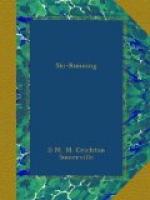A slope showing eight 30-metre contour lines in one centimetre works out roughly at 27 deg., which is a steeper slope than most people care to take straight, running over unknown country. Anything steeper than this is apt to avalanche in certain conditions, though a 30 deg. slope should usually be safe. (A 25 deg. slope may be dangerous under some conditions.)
A comfortable slope is 5 contour lines in 1 centimetre, or a gradient of 17 deg.. Taking English measurements as in Commander Merriman’s scale, 16 contour lines in one inch on the map.
The beginner will probably content himself with slopes where 10 contour lines are shown in one inch, or a gradient of about 13 deg..
Rough table of gradients.
Assuming 30 metre contours to be equal to 100 feet contours (actually this is 98.4 feet). Natural Scale 1: 50,000.
-------------------------------------------- Drop per inch | Average angle | Gradient on map. | of slope. | 1 in. -------------------------------------------- 100’ | 1 deg. 24’ | 40.9 200’ | 2 deg. 45’ | 20.8 300’ | 4 deg. 07’ | 13.9 400’ | 5 deg. 29’ | 10.4 500’ | 6 deg. 50’ | 8.3 600’ | 8 deg. 12’ | 6.9 700’ | 9 deg. 33’ | 5.9 800’ | 10 deg. 52’ | 5.2 900’ | 12 deg. 11’ | 4.6 1,000’ | 13 deg. 30’ | 4.2 1,100’ | 14 deg. 47’ | 3.8 1,200’ | 16 deg. 04’ | 3.5 1,300’ | 17 deg. 20’ | 3.2 1,400’ | 18 deg. 34’ | 3.0 1,500’ | 19 deg. 48’ | 2.8 1,600’ | 21 deg. 00’ | 2.6 1,700’ | 22 deg. 11’ | 2.5 1,800’ | 23 deg. 22’ | 2.3 1,900’ | 24 deg. 30’ | 2.2 2,000’ | 25 deg. 39’ | 2.1 2,100’ | 26 deg. 45’ | 2.0 2,200’ | 27 deg. 50’ | 1.9 2,300’ | 28 deg. 53’ | 1.8 2,400’ | 29 deg. 56’ | 1.7 2,500’ | 30 deg. 58’ | 1.6 --------------------------------------------
Up till now I have only been describing the official Ordnance Maps. There are several other maps which may also be useful.
The Dufour maps are good for direction and lie of country, but their scale being 1 in 100,000 they are not much help for actual running.
The local Ski Tour Map is useful to show where the usual tours go, but cannot always be trusted for gradients or cliffs and rocks. The Pontresina map, for instance, though showing an equidistance of 30 metres as in the Ordnance Maps, really has 50 metres contour lines, which might be a terrible snare to the unwary, who would confidently run towards a slope, thinking it was about 20 deg. and find that it was nearer 35 deg., or an avalanche slope. In a case like this the Ordnance Map must be used for actual running, while the Ski Tour Map is used to show the line to be followed.




